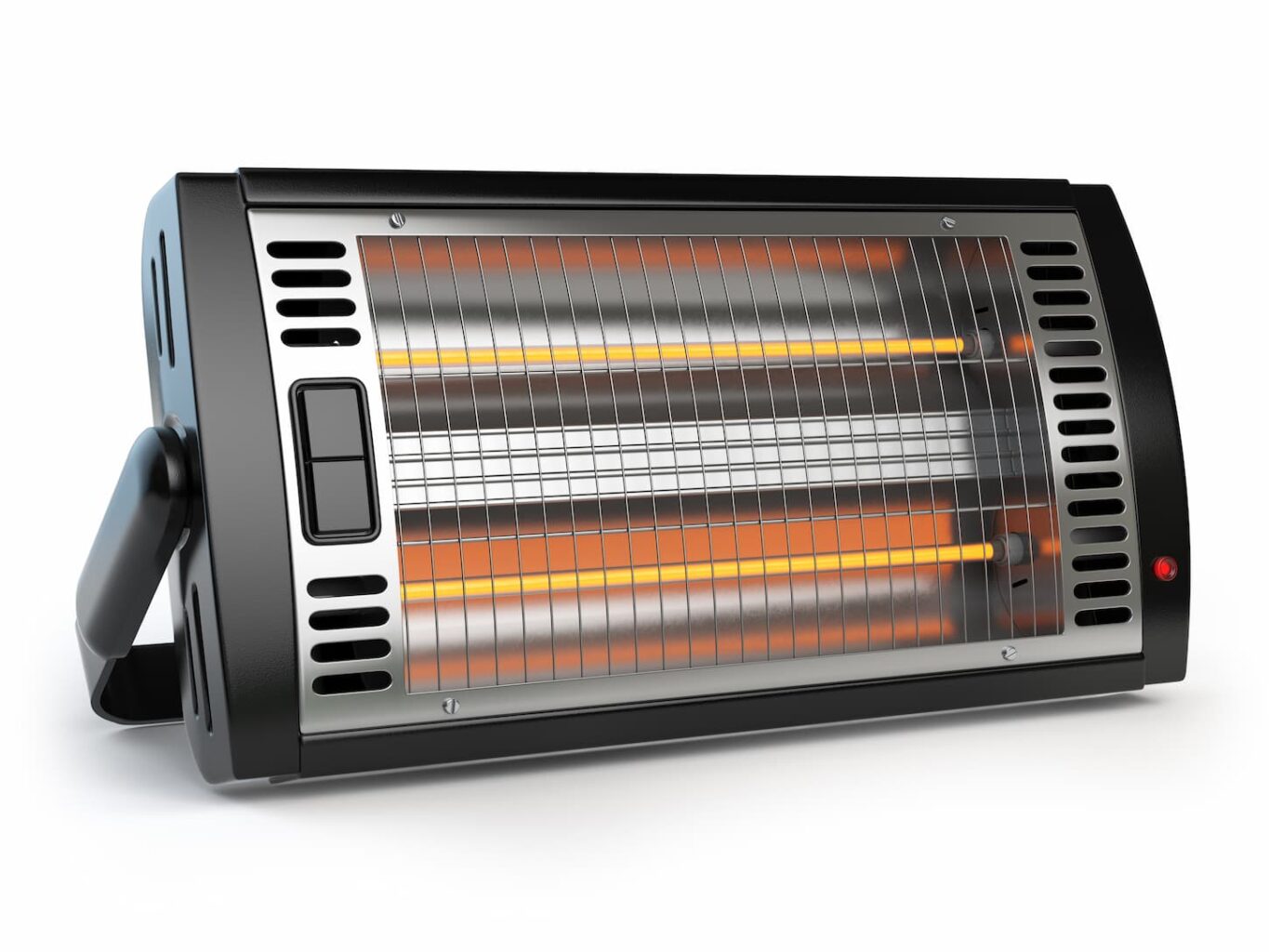Baby goats are loveable and precious! Nurturing them from birth can be super tough, especially when they’re super small. If they’re small enough, then you’re at that point where you’re wondering if your baby goats need a heat lamp in order to survive and thrive.
Heat lamps are great warming methods for baby goats but are only needed for extreme situations or complications where a warm towel or the mother goat’s body heat isn’t sufficient. The chances of heat lamps causing an accident are high and can lead to unwanted livestock losses.
The arrival of a baby goat requires extra precautions during winter. This is because the babies are at risk of freezing to death. One thing is for sure, knowledge is key and we are going to help you gain insights on how to care for your baby goats during these cold times.

Are Heat Lamps a Necessity?
Heat lamps are not a necessity and pose a real fire risk. Heat lamps can help baby goats regulate their body temperature, although this regulation does not provide substantial warmth for them nor does it replace the warmth from their family and herd.
Baby goats are better off with their mother doe’s body warmth than a heat lamp. Placing a heat lamp with the mother and baby could cause them to run into an accident by unintentionally hitting the lamp and hurting or burning themselves.
Heat lamps are not the safest and are far from babyproof – or goatproof. There are horror stories of heat lamps causing a fire, completely destroying barns, and harming the animals. Or if you keep your goats locked up at night, there are also horror stories of heat lamps causing fires that destroy the barn and all of the animals inside.
Anything can happen at night while you are asleep; the babies could chew on the electrical cords or hop on the lamp and fall alongside it. Sometimes the bulbs shatter and throw sparks.
- The smartest thing to do is to purchase radiant heaters that are less hazardous than traditional heat lamps. This one is our favorite (click here to see it on Amazon). Technically, it’s advertised for chickens. But we’ve found it works with our other animals, too.
- If you’d like to stick with the traditional heat lamp, this is the kind of heat lamp bulb that we’ve used. It’s one of the safer options out there (and is available on Amazon).
Whichever one you choose, make sure you secure them in place. Keep them out of reach of your animals, but close enough for the babies to regulate their body temperature and produce heat.
Here’s when a heat lamp is nice to have
If the circumstances that surrounded the baby’s birth weren’t pretty, you might just want to have a heat lamp. In these cases, they can be a huge help.
- The baby goat was born sickly and weak.
- The doe rejected the baby goat.
- Proper bedding preparations were not made.
- The mother gave birth at the wrong time and place.
- There’s a severe weather issue and the extra heat is needed.
When situations like this arise, a heat lamp is your best shot at keeping the baby goat warm.
That being said, there are definitely other ways to keep the kid warm that don’t involve the heat lamp. But then you’re probably going to be bringing the kid into your home to keep it warm. If having a house kid doesn’t appeal to you, then you may want the heat lamp or radiant warmer.
Do Baby Goats Need to Be Kept Warm?
Baby goats need warmth, especially during the cold seasons, as they have just transitioned from being in their mother’s womb, and will need time to better regulate their body temperature as they adjust to the climate of their environment.
Some areas have colder weather than others during the kidding season, so it is important to be at the top of your game during those periods to avoid losing your baby goats. Baby goats are not as independent as adult goats – they can’t be out in the elements without precautions.
You can keep your goats warm using the following tips.
Tip #1: Let kids (and their mom) cuddle.
Allow the babies to cuddle and share body warmth. There is nothing wrong with taking the baby off its mother in the daytime and bringing it back to feed at night.
Tip #2: Build your goats a wind-free barn.
This will reduce the consistency of the harsh breeze coming in and also prevent the goat’s body heat from seeping out. If your barn has some draft issues, then do what you can to minimize the draftiness. It can be temporary measures like using straw inside pallets to shore up the walls.
Tip #3: Give your kid a coat.
You can sew up a small sweater for your babies to cool them down. If you can’t sew, then there are some other options out there. Most kids should fit inside dog sweaters, for example. Then not only do they look absolutely adorable in them, but a sweater will also keep your goats very warm.
Tip #4: Use a hairdryer to warm up your kids.
If they get wet from the snow or rain, get a hairdryer running and dry them until they are warm enough. A hairdryer can also be a great way to dry and warm up newborn goats.
Tip #5: Use good bedding to keep the barn warm.
Straw is a perfect bedding material; it is very warm both as bedding and liter material. You can mix straw with pine pellets and/or pine shavings to keep the litter clean enough to double as bedding material.
Tip #6: Give your goats drinkable water.
Your goats need good drinking water. It doesn’t have to be warm – but it does have to be “not frozen” so they can drink it. Being able to drink water definitely helps them during the cold season.
Now, all this being said, I do have a word of warning for you. You don’t want your goats (and other livestock) to depend on heaters for warmth. They need to learn to regulate their body temperature themselves. This will make them stronger and more receptive to harsh weather as they get older.
So whether you’re using warm towels, a heater, or a hairdryer, make sure you transition your kids off of those devices over time and as their health allows. If you aren’t sure about their health, please make sure you consult with your veterinarian.
Are Baby Goats OK in the Cold?
Baby goats are generally fine in cold weather as long as they have their mother, family, and/or herd to stay warm. A healthy 2-weeks old baby goat can easily survive mild cold weather depending on its current health situation and if there were any complications at birth.
While baby goats have the stamina required to endure the cold weather, they should not be in situations where they could get wet while staying in the cold. This can lead to them getting sick from the cold. If your baby goats get wet during cold weather, it’s important to warm them up at all costs.
Now, that’s for healthy baby goats. What about weaker baby goats?
Weaker baby goats are prone to hypothermia and can lose the tips of their ears due to frostbite, depending on local weather conditions. If the weather is bad enough, then you can lose those baby goats quickly.
That’s why it’s important to both keep an eye on weaker baby goats and be familiar with the symptoms of hypothermia. Contact your veterinarian immediately if you notice any symptoms of hypothermia or other concerning symptoms in your baby goats.
What Temperature Does Baby Goats Need?
Baby goats need to maintain a steady body temperature of 102-103 degrees Fahrenheit. Baby goats are generally safe without supervision as long as the environmental temperature is above 40 degrees Fahrenheit. Baby goats need regular supervision at temperatures below 40 degrees Fahrenheit and may need additional interventions if the temperature drops below 0 (zero) degrees Fahrenheit.
Baby goats can generally survive anything as long as they are dry, are on proper beddings, have their mom and siblings to keep them warm, their home is draft-free, and they are being fed adequately. In those conditions, baby goats can regulate their body temperature just fine.
That being said, baby goats don’t need to be outside during blizzards or extreme weather as they can become sick pretty quickly – especially if they get wet while being cold.
Pro tip: baby goats also don’t like it being too hot. So if you live in a warmer environment, make sure you get a breed that will do well in your climate – or build them an appropriate shelter so they’ll be safe and healthy.
Summary
Baby goats are pretty much the only thing better than goats! They are so stinking cute.
So when you do add goats (and kids) to your backyard homestead, it’s important to do all you can so you don’t lose any of them. And, as you now know, heat lamps aren’t a necessity – but they can be nice to have.
Whether you get one or not, make sure you use our other tips to keep your goats and kids plenty warm during the kidding season – whether it’s during the winter or spring and no matter the temperature outside.
Next, make sure you’re ready for kidding season and make sure that you’re ready for baby goats who need a bottle but don’t want to take it with these tips and tricks I’ve prepped for you based on tips that actually work.
Resources
Learning from your own experience is essential, but learning from others is also intelligent. These are the sources used in this article and our research to be more informed as homesteaders.
- Hess, Tara. “Care Recommendations For Goat Kids.” The Open Sanctuary Project, 17 May 2021, opensanctuary.org/article/special-care-recommendations-for-goat-kids/.
- Goats. “Care of Goats in Severe Winter Weather.” Goats, 14 Aug. 2019, goats.extension.org/care-of-goats-in-severe-winter-weather/.
- Metzger, Michael. “Winter Management Tips for Goats.” Sheep & Goats, 12 Jan. 2021 canr.msu.edu/news/winter-management-tips-for-goats.
- Niemann, Deborah. “Goats in Winter.” The Thrifty Homesteader, 21 Mar. 2020, thriftyhomesteader.com/goats-in-winter/.
- Niemann, Deborah. “Kidding in Winter.” The Thrifty Homesteader, 14 Feb. 2020, thriftyhomesteader.com/kidding-in-winter/.
- nubians2. “How Cold Is Too Cold for Kidds?” The Goat Spot Forum, 7 Apr. 2012, www.thegoatspot.net/threads/how-cold-is-too-cold-for-kidds.130416/.
- “Preparing For (Winter) Baby Goats!!!!” YouTube, 1 Jan. 2019, youtu.be/q4cZ36GkUV4/.
